An assembly of nuclear bodies associates with the active VSG expression site in African trypanosomes
- PMID: 35013170
- PMCID: PMC8748868
- DOI: 10.1038/s41467-021-27625-6
An assembly of nuclear bodies associates with the active VSG expression site in African trypanosomes
Abstract
A Variant Surface Glycoprotein (VSG) coat protects bloodstream form Trypanosoma brucei. Prodigious amounts of VSG mRNA (~7-10% total) are generated from a single RNA polymerase I (Pol I) transcribed VSG expression site (ES), necessitating extremely high levels of localised splicing. We show that splicing is required for processive ES transcription, and describe novel ES-associated T. brucei nuclear bodies. In bloodstream form trypanosomes, the expression site body (ESB), spliced leader array body (SLAB), NUFIP body and Cajal bodies all frequently associate with the active ES. This assembly of nuclear bodies appears to facilitate the extraordinarily high levels of transcription and splicing at the active ES. In procyclic form trypanosomes, the NUFIP body and SLAB do not appear to interact with the Pol I transcribed procyclin locus. The congregation of a restricted number of nuclear bodies at a single active ES, provides an attractive mechanism for how monoallelic ES transcription is mediated.
© 2022. The Author(s).
Conflict of interest statement
The authors declare no competing interests.
Figures

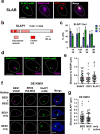
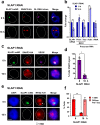
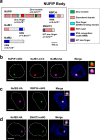
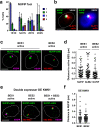
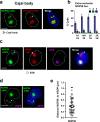

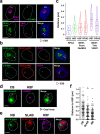
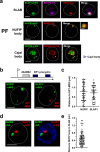

Similar articles
-
RNA polymerase I transcribes procyclin genes and variant surface glycoprotein gene expression sites in Trypanosoma brucei.Eukaryot Cell. 2003 Jun;2(3):542-51. doi: 10.1128/EC.2.3.542-551.2003. Eukaryot Cell. 2003. PMID: 12796299 Free PMC article.
-
A foreign transcription unit in the inactivated VSG gene expression site of the procyclic form of Trypanosoma brucei and formation of large episomes in stably transformed trypanosomes.Mol Biochem Parasitol. 1995 Feb;69(2):223-38. doi: 10.1016/0166-6851(94)00186-q. Mol Biochem Parasitol. 1995. PMID: 7770086
-
Analysis of a hybrid PARP/VSG ES promoter in procyclic trypanosomes.Mol Biochem Parasitol. 1996 May;77(2):147-59. doi: 10.1016/0166-6851(96)02588-1. Mol Biochem Parasitol. 1996. PMID: 8813661
-
Regulation of antigen gene expression in Trypanosoma brucei.Trends Parasitol. 2005 Nov;21(11):517-20. doi: 10.1016/j.pt.2005.08.016. Epub 2005 Aug 29. Trends Parasitol. 2005. PMID: 16126458 Review.
-
Transcription of protein-coding genes in trypanosomes by RNA polymerase I.Annu Rev Microbiol. 1997;51:463-89. doi: 10.1146/annurev.micro.51.1.463. Annu Rev Microbiol. 1997. PMID: 9343357 Review.
Cited by
-
TelAP2 links TelAP1 to the telomere complex in Trypanosoma brucei.Sci Rep. 2024 Dec 16;14(1):30493. doi: 10.1038/s41598-024-81972-0. Sci Rep. 2024. PMID: 39681615 Free PMC article.
-
Mono-allelic epigenetic regulation of polycistronic transcription initiation by RNA polymerase II in Trypanosoma brucei.mBio. 2025 Feb 5;16(2):e0232824. doi: 10.1128/mbio.02328-24. Epub 2024 Dec 20. mBio. 2025. PMID: 39704500 Free PMC article.
-
The RNA export factor TbMex67 connects transcription and RNA export in Trypanosoma brucei and sets boundaries for RNA polymerase I.Nucleic Acids Res. 2023 Jun 9;51(10):5177-5192. doi: 10.1093/nar/gkad251. Nucleic Acids Res. 2023. PMID: 37070196 Free PMC article.
-
Next generation genetic screens in kinetoplastids.Nucleic Acids Res. 2025 Jun 6;53(11):gkaf515. doi: 10.1093/nar/gkaf515. Nucleic Acids Res. 2025. PMID: 40530689 Free PMC article. Review.
-
Pedal to the Metal: Nuclear Splicing Bodies Turbo-Charge VSG mRNA Production in African Trypanosomes.Front Cell Dev Biol. 2022 Apr 20;10:876701. doi: 10.3389/fcell.2022.876701. eCollection 2022. Front Cell Dev Biol. 2022. PMID: 35517511 Free PMC article. Review.
References
Publication types
MeSH terms
Substances
Grants and funding
LinkOut - more resources
Full Text Sources
Other Literature Sources
Research Materials

